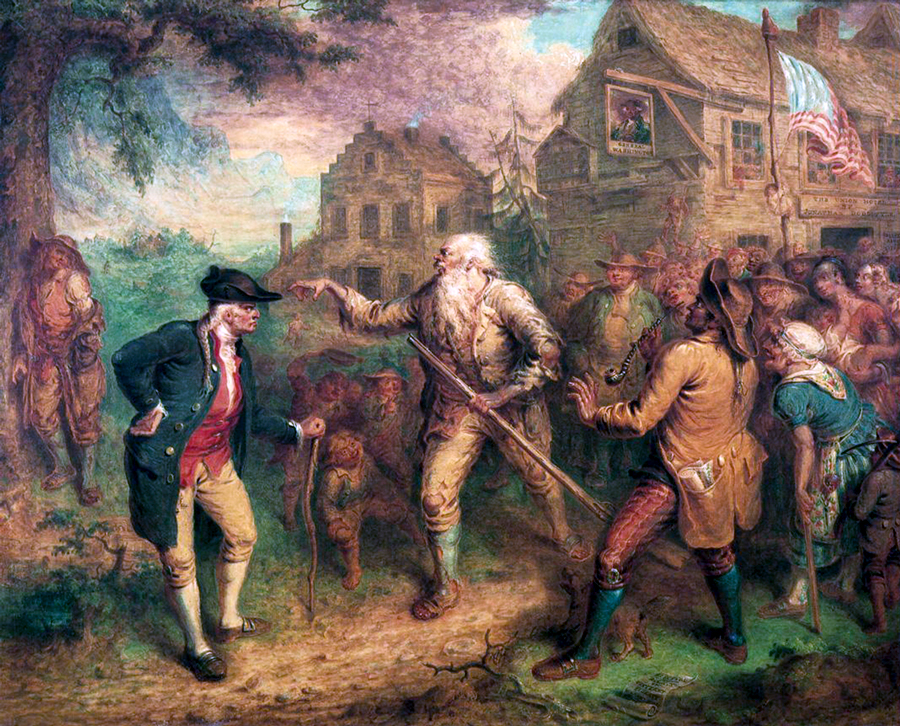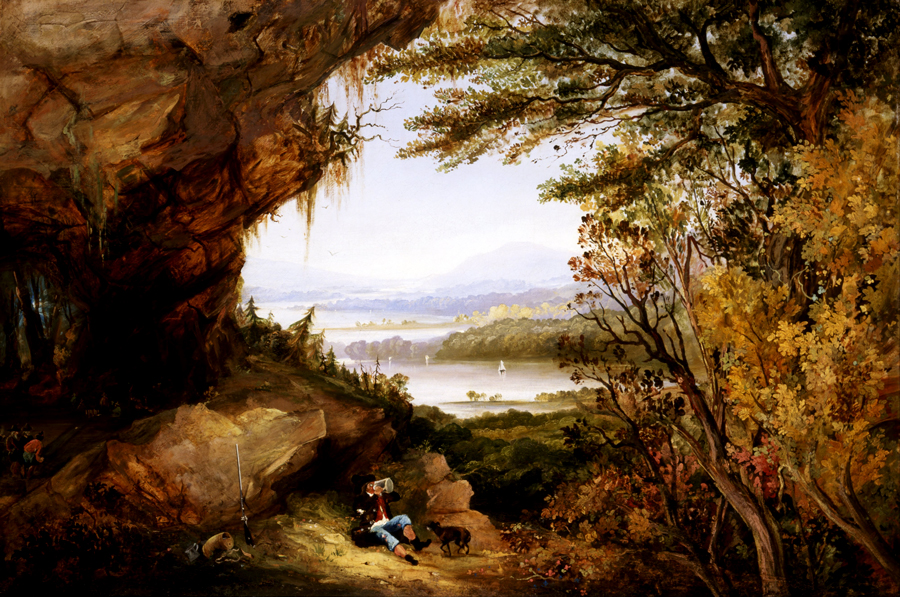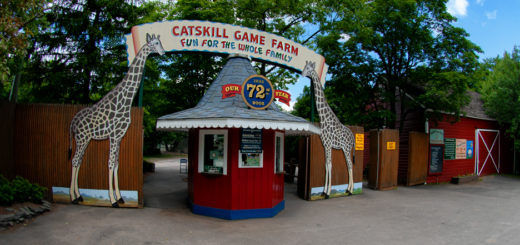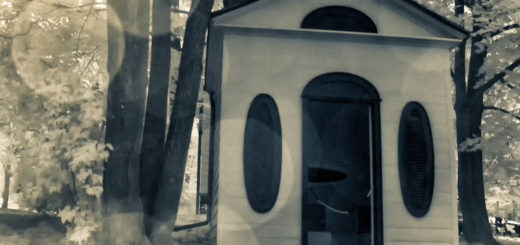The Return of Rip Van Winkle
The most prominent landmark in the Catskills is not a mountain but a character by the name of Rip Van Winkle. It’s surprising how many take him to be an historical figure as opposed to the fictional creation of Washington Irving that he actually is. Or perhaps it’s not surprising, given how often his name pops up in the region, emblazoned on everything from hotels to real estate offices to storage facilities. There’s even a bridge. One also hears the occasional report of a tombstone bearing his name. I myself came upon one, many years ago, on a wooded mountainside not far from my home. The marker was inscribed with these words:
Just above upon this crest
For twenty years Rip took a rest
Now he’s gone where all men go . . . .
Sadly, the rest of the epitaph is lost, the aged stone having been broken off right at the punch line.
June 2018 marks the bicentennial of the writing of “Rip Van Winkle.” Interestingly, this round of scribbling did not take place in the Catskills but rather in England. Irving admitted that at the time he wrote the tale, he had never set foot in the Catskills, but this did not stand in the way of “Rip Van Winkle” becoming one of the most beloved of all of American stories.
Most readers will recall “Rip Van Winkle” as the story of a middle-aged ne’re-do-well, who one day—along with his dog—lights out from his sleepy village for the “Kaatskill Mountains,” ostensibly to hunt squirrels but really to escape the censures of his wife. Making his way to the wildest heights of the range, he stumbles upon an outlandish albeit dour crew of men trying to amuse themselves by playing ninepins and drinking from a keg of mysterious brew. When nobody is looking, Rip helps himself to a few drafts, and as a result falls into a deep sleep lasting twenty years.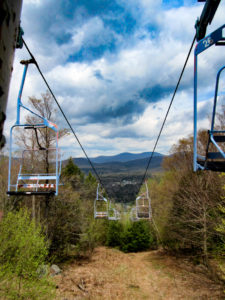
He awakens to find his gun rusted, his dog missing, and his beard long and grizzled. Rip then makes his way down the mountain and back to his village, only to discover everything there has changed. He knows nobody and nobody knows him. A crowd gathers and looks on him with suspicion, ready to drive this unkempt stranger from their midst. In what has always struck me as the most poignant moment in the story, Rip’s own daughter steps out from the crowd and fails to recognize him. He cries out: “I am your father! Young Rip Van Winkle once—old Rip Van Winkle now!—does nobody know poor Rip Van Winkle!” Just at the point when the crowd is ready to turn on him, an old woman totters forth and exclaims: “Sure enough!—it is Rip Van Winkle!—welcome home again old neighbor.” Thus he is restored to the community.
Rip himself was lucky—his identity was confirmed and he “resumed his old walks and habits.” The rest of his days were spent happily sitting around telling the story of his marvelous encounter in the Kaatskills to anybody who would listen. And there were plenty of people eager to hear the old man’s tale. Rip had quite a following in his later years and enjoyed a reputation as a masterful storyteller.
But it could have gone otherwise. Caught between a past that cannot not be regained and a present that has no place for him, Rip is momentarily suffering the fate of old age. Had his identity not been corroborated by the old woman, had that mob turned on him, this doddering, homeless man with a crazed yarn might have been put away in a secure facility with “memory care”—if only they had such a thing in those days. More likely, old Rip simply would have been cast out of the village and left to fend for himself, alone in a world that no longer had a place for him. And this is where the story makes its dark implication: live long enough, reader, and you too will become a Rip Van Winkle. It happens in that moment when you first hear yourself saying: “Where did all the years go?”
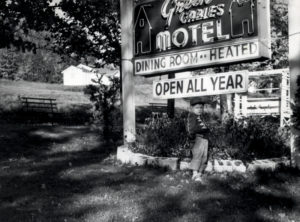 Rip returned to his village possessing no memory of those twenty years, not even of his dreams. He slept through it all, having fallen into oblivion, yet somehow—miraculously—he “came back to life.” Most of us in our ordinary lives don’t suffer this kind of breach in memory, though truth be told we hardly attend to the myriad little details that make up our world. We proceed blithely through our days, seldom taking note of the familiar names and places that are slowly, inevitably disappearing from the Mountaintop landscape—until one day we awaken and find ourselves asking questions like: “Whatever happened to the Blue Moon?” “When did Cortina Valley shut down?” “How long since North and South Lakes became one?” “Where did all those Rip Van Winkle statues go that I used to see everywhere?” “Who was the proprietor of the Green Gables?” “When was the Mountain Drive-In shuttered?” “Where was Rip’s Retreat?” “Does anybody remember the Edward James? Or Seeley’s Tavern?” “And whatever became of the Windham Journal?”
Rip returned to his village possessing no memory of those twenty years, not even of his dreams. He slept through it all, having fallen into oblivion, yet somehow—miraculously—he “came back to life.” Most of us in our ordinary lives don’t suffer this kind of breach in memory, though truth be told we hardly attend to the myriad little details that make up our world. We proceed blithely through our days, seldom taking note of the familiar names and places that are slowly, inevitably disappearing from the Mountaintop landscape—until one day we awaken and find ourselves asking questions like: “Whatever happened to the Blue Moon?” “When did Cortina Valley shut down?” “How long since North and South Lakes became one?” “Where did all those Rip Van Winkle statues go that I used to see everywhere?” “Who was the proprietor of the Green Gables?” “When was the Mountain Drive-In shuttered?” “Where was Rip’s Retreat?” “Does anybody remember the Edward James? Or Seeley’s Tavern?” “And whatever became of the Windham Journal?”
These and innumerable other touchstones by which we make our way through daily life are constantly fading from the scene. If any memory of them is to survive, it will be in the form of stories, some written but most of them told aloud to an accommodating audience—around kitchen tables, in local taverns, in convenience stores, in backyard barbeques, and at holiday gatherings. And each time one of these tales of bygone days is recounted, it will be as if Rip Van Winkle were once again returning home.
©John P. O’Grady
(This piece originally appeared in the January 26, 2018 edition of The Mountain Eagle.)
